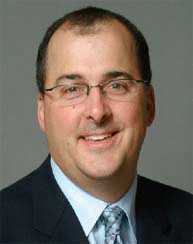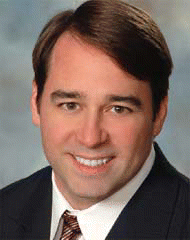When repairing a spontaneous cerebrospinal fluid (CSF) leak, the surgeon needs to take extra measures to guard against recurrence, according to a team of investigators at the University of Pennsylvania.
Explore This Issue
May 2008Because such leaks have a higher recurrence rate than those occurring secondary to external events, such as trauma or surgery, the team developed a paradigm for managing spontaneous CSF leaks, which they presented at the 2007 annual meeting of the American Academy of Otolaryngology-Head and Neck Surgery (AAO-HNS).
 The important steps are to first identify what type of leak the patient has-whether iatrogenic, traumatic, congenital, tumor, or spontaneous-and, second, if it is spontaneous, to determine whether the CSF pressure is normal or elevated.
The important steps are to first identify what type of leak the patient has-whether iatrogenic, traumatic, congenital, tumor, or spontaneous-and, second, if it is spontaneous, to determine whether the CSF pressure is normal or elevated.-James Palmer, MD
The important steps are to first identify what type of leak the patient has-whether iatrogenic, traumatic, congenital, tumor, or spontaneous-and, second, if it is spontaneous, to determine whether the CSF pressure is normal or elevated, said James Palmer, MD, Director of the Division of Rhinology and A ssociate Professor in the Department of Otorhinolaryngology-Head and Neck Surgery at the University of Pennsylvania. If you can identify the nature of the leak, then you can identify the appropriate mechanism for repairing it.
Intracranial Pressure Increases Risk of Recurrence
Dr. Palmer noted that spontaneous CSF leaks are more likely to be associated with an abnormally high CSF pressure. In those cases, repair with an autologous bone graft is helpful to prevent recurrence, he said.
In the data presented at the AAO-HNS meeting, the investigators stressed that intracranial hypertension is often the underlying factor in the development of spontaneous CSF leaks. The increased pressure can also put the repair at a higher risk of recurrence than leaks due to trauma or spontaneous leaks with a normal baseline intracranial pressure.
The retrospective review on which the paradigm is based analyzed the results of 53 patients who underwent endoscopic repair of spontaneous CSF leaks. The patients’ average age was 61 years, with a range of 19 to 79 years, and they had an average body mass index (BMI) of 36.2. All patients presented with rhinorrhea due to their CSF leaks, and 10 had meningitis.
The most common defect was in the lateral sphenoid sinus, which was present in 23 patients; ethmoid roof defects were documented in 14 patients. In the remaining patients, 11 had defects in the cribriform plate and seven each had central sphenoid and frontal sinus defects. Among these patients, nine had multiple CSF leaks at the time that they were treated, and the vast majority, 50 patients (94%), had associated encephaloceles.
In 28 months of follow-up, 50 patients (94%) had successful repairs at the first attempt without recurrences. The lumbar drain pressures were recorded on 40 of 53 patients, who had an average of 27.9 cm of water. To address the intracranial hypertension, the treating physicians used acetazolamide or, in severe cases, a ventriculoperitoneal shunt.
Bone Grafts Provide Stronger Support
Although there are multiple approaches to repair leaks in the setting of elevated CSF pressure, the goal should be a mechanism that gives stiffer, stronger support than was present before the leak, Dr. Palmer said. Therefore, we recommend using bone in the closure, he said. The bone tissue should be autologous, and can be harvested from the septum, mastoid tip, or turbinate.
 Otolaryngologists need to know that there are different types of CSF leaks, primarily spontaneous leaks and those that occur following a traumatic event such as sinus surgery. They also should know that CSF can leak into the temporal bone or ear as well as the nose.
Otolaryngologists need to know that there are different types of CSF leaks, primarily spontaneous leaks and those that occur following a traumatic event such as sinus surgery. They also should know that CSF can leak into the temporal bone or ear as well as the nose.-Todd Kingdom, MD
Tips for Preventing Complications
Dr. Palmer went on to describe several other measures to take when repairing spontaneous CSF leaks. For example, the surgeon should take care to prevent fistula regrowth by ensuring that the mucosa is removed at least 0.5 cm away from the site of the leak in all dimensions. If you are working in an anatomic area with thinned bone, consider bone from the turbinate, he advised. Then you’ll be placing a thinner, collapsible bone into the deficit. You could cause a fracture and an increase in the size of the deficit if you use a thicker bone, such as the mastoid, in such settings.
When the harvested bone is in place, he and his colleagues often seal the site with fibrin glue. The glue can cause scarring, which is desirable in the setting of CSF leak repair, he said. The site should then be covered with some form of soft tissue, such as the septal mucosa, the turbinate mucosa, or temporalis fascia. Finally, surgeons should be sure to avoid blocking the drainage of other sinuses and the subsequent collateral damage, he said.
The critical issue is to make sure you are aware of the baseline CSF pressure of the patient, he said. If it is high, you need more advanced techniques for closure to get the 95 percent to 100 percent success rate we see with other types of CSF leaks. A mucosal graft without bone support is often unsuccessful in these cases.
Increased intracranial pressure is the current focus in the assessment and management of spontaneous CSF leaks, said Richard Lebowitz, MD, a sinus specialist and Assistant Professor of Otolaryngology at New York University Medical Center. Otolaryngologists need to recognize that a patient with a spontaneous CSF leak often has increased intracranial pressure and is very different from a patient with a leak due to an injury, he continued.
Risk Factors
Certain patients are at increased risk of such leaks, said Dr. Lebowitz. The typical patient is an obese, middle-aged woman, he said. If you see a patient with those characteristics and clear fluid coming out of her nose, you would have a higher index of suspicion for a spontaneous CSF leak than you would with a patient with clear nasal drainage without those risk factors. The risk is further increased in patients who have a history of head trauma or prior sinus surgery, he said.
The endoscopic approach used in the study is the most appropriate in most cases. This is generally a more effective and less morbid surgical approach than repair via a craniotomy, Dr. Lebowitz said. Spontaneous leaks have a slightly greater recurrence rate for a good reason-the increased intracranial pressure. You have to reduce the pressure to prevent recurrence.
The fact that patients who have spontaneous leaks are more likely to have underlying elevated intracranial pressure necessitates that the otolaryngologist evaluate and potentially treat such patients in conjunction with a neurosurgeon, he said.
Leaks Not Confined to Nose
Otolaryngologists need to know that there are different types of CSF leaks, primarily spontaneous leaks and those that occur following a traumatic event such as sinus surgery, said Todd Kingdom, MD, Associate Professor of Otolaryngology and Director of Rhinology and Sinus Surgery at the University of Colorado Health Sciences Center in Denver, who was not involved in the study. They also should know that CSF can leak into the temporal bone or ear as well as the nose.
Dr. Kingdom agreed with Dr. Lebowitz about the risk factors associated with spontaneous leaks. Why that occurs isn’t entirely clear, he said. We know that intracranial hypertension can weaken bone and membranes that are already thin, and that this condition is more associated with obesity. The persistent elevated pressure can thin the bone of the skull base even further.
Approaches in Postoperative Shunts
Dr. Kingdom agreed with the investigators that a spontaneous CSF leak needs to have sound repair, including both accurate location of the defect and the steps involved in repairing it. Noting that the investigators discussed medical therapy and the use of shunts as ways to reduce intracranial pressure, Dr. Kingdom stressed that there are several methods of shunting. The most direct is the use of a lumbar drain for three to five days after surgery. A more permanent approach is a ventriculoperitoneal shunt. It’s the most invasive, but it’s the most definitive.
Initially, I typically place a lumbar drain for three days following repair in patients with evidence of elevated intracranial pressure, he said. I will use a more permanent shunt in cases where the initial repair failed.
Dr. Kingdom agreed with Dr. Palmer that bone or other rigid structures should be used in larger defects. However, he noted that experts have not agreed on whether a leak size of 5 mm or 10 mm should be the threshold at which the use of bone should be considered. Dr. Kingdom uses biologic glues and adhesives over the bone, and, like Dr. Palmer, uses autologous soft tissue as the final layer, such as mucus membrane from the nose, fat, or fascia.
News & Notes
OTC Earwax Softener May Be Harmful
An over-the-counter (OTC) earwax softener may cause inflammation to the eardrum and inner ear, according to a recent study.
Researchers from McGill University in Montreal, led by Sam Joseph Daniel, MD, MSc, assessed the effect of ototopic triethanolamine polypeptide oleate condensate 10% (Cerumenex, an OTC earwax softener) on hearing in five chinchillas in a prospective, randomized, controlled trial. Tympanostomy tubes were inserted in the chinchillas, and hearing was assessed with distortion product otoacoustic emissions (DPOAE) between 1 and 9 kHz prior to application and at days 1, 4, 30, and 100 postototopic application of Cerumenex. Postmortem scanning electron microscopy was performed to assess cochlear hair cells.
Researchers found a reduction in the mean DPOAE signal in the treated ears from the first day after the treatment and throughout the study. They also found swelling, crusting, and fluid in four of the five Cerumenex-treated ears, and post-treatment facial paralysis in one case. Electron microscopy revealed damage to the outer and inner hair cells of the treated ears.
The researchers, who published their results in the December 2007 issue of Laryngoscope, conclude that further studies on the efficacy and safety of Cerumenex and other cerumenolytics on both animal and human hearing be conducted. In the meantime, the researchers recommend that caution be observed when prescribing these products and that their use without medical prescription be discouraged.
©2008 The Triological Society
Leave a Reply